Tetragonia fruticosa
Tetragonia fruticosa L.
Family: Aizoaceae
Common names: sprawling sea coral, trailing dune-spinach (Eng.); kinkelbossie, kinkelklappers, kleinsaadklappiesbrak, klimopkinkelbossie, porseleinbos, slaaibos, waterslaaibos (Afr.)
Introduction
A bushy shrub with a yellow-green appearance and a red tinge, and in bright sunlight it appears to glisten, because the plant is covered in striking, minute watery papillae.

Description
Description
Tetragonia fruticosa is a sprawling, much-branched, shrubby perennial with white woody stems at the base when growing in open spaces but plants often scramble into taller shrubs and branches (Vlok 2015). On old lands in sandy soil it grows prostrate. Where the soil is heavier in the Succulent Karoo and Karroid Broken Veld the plant rarely reaches a height of 250 mm (Van Breda & Barnard 1991).
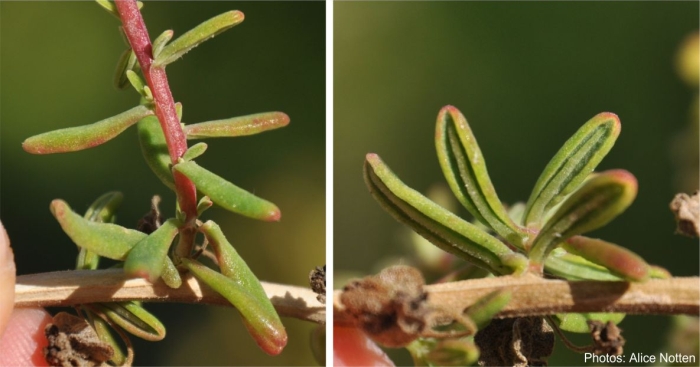
The leaves are soft, slightly fleshy, narrow with margins that are rolled under and the surface covered in papillae. Flowers are small, dull yellow with four petal-like sepals, borne in the axils, in spring and early summer, from September to January. Fruits are 1-seeded, 4-winged, indehiscent and slightly fleshy when fresh, turning brown when mature.
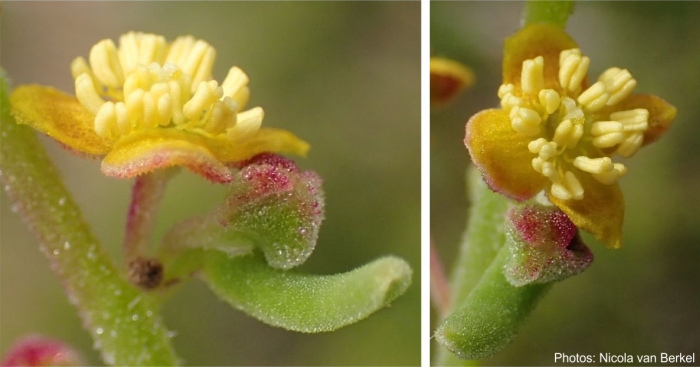
Conservation Status
Status
Tetragonia fruticosa is currently assessed as Least Concern (LC) in the Red List of South African plants. This means that the species is not threatened and is not at a risk of becoming extinct.
Distribution and habitat
Distribution description
Plants are abundant in sandy or loamy soils in all habitat types, except upper mountain slopes (Protea and Erica Fynbos) (Vlok 2015). This widespread species grows in arid and semi-arid areas, on granite and sandstone slopes especially along the coast, to about 1 100 m from Namaqualand to the Eastern Cape.
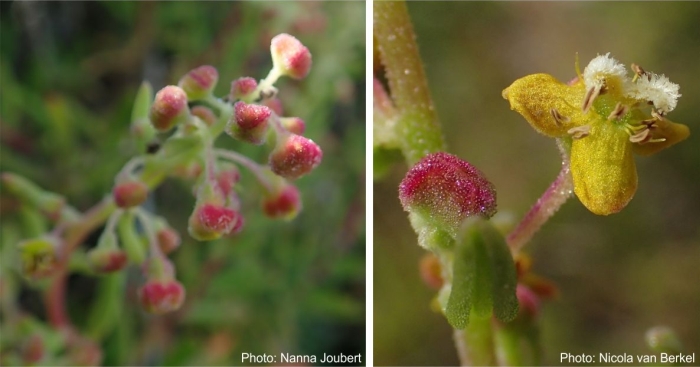
Derivation of name and historical aspects
History
The name of the genus Tetragonia comes from the Latin, tetragonus which means ‘4-angled’, relating to the fruit, and the Latin specific epithet fruticosum refers to the plant’s growth form as being ‘shrubby’.
The genus Tetragonia has about 60 species of which 12 species occur in the Klein Karoo and about 10 are fynbos species. These perennial plants, are palatable to game and stock and are important fodder plants.
The common name kleinsaadklappiesbrak, meaning ‘small-seeded rattle-saltbush’ is used to distinguish it from other members of the genus such as grootsaadklappiesbrak, meaning ‘large-seeded’-klappiesbrak (Tetragonia hirsuta) and kinkelklappiesbrak, meaning ‘twisted’-klappiesbrak (Tetragonia spicata). Klappies, meaning ‘rattle’, is derived from the rattling sound made by the seeds in the capsules, and brak means ‘salty’, referring to the way these plants can grow in brackish soils. The small, glistening papillae on the leaves shine like porcelain or glass, this is why the common name porseleinbos is also used. The other common names: kinkelbossie, meaning twisted bush, is derived from the slight twist in the stems or branches, klimopklappiesbrak means ‘climbing’-klappiesbrak, referring to its scrambling habit and slaaibos means ‘salad bush’, referring to its edibility.
Most plants belonging to the family Aizoaceae (the Vygie family) have seed capsules that are dependent on water droplets, to open up the capsules and release the seeds. Interestingly enough this is not the case with Tetragonia as the ripe fruit is single-seeded, indehiscent and dispersed by wind.
The eye catching Tetragonia herbacea with its ground hugging form of growth and pear-shaped fruits is another interesting species of this genus.
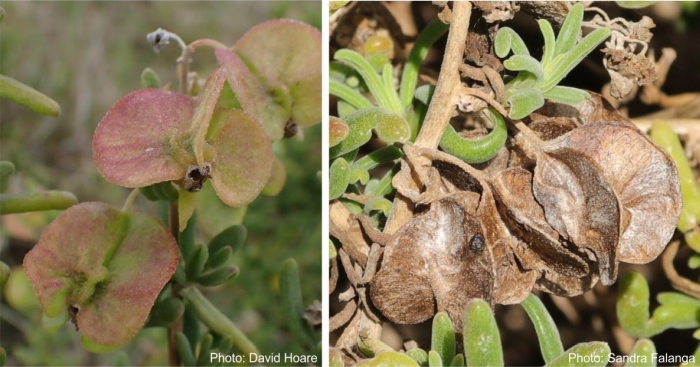
Ecology
Ecology
Honey bees pollinate the small yellow flowers which are rich in pollen and nectar. Few insects seem to feed on this plant, even slugs and snails do not. The seed is borne in a 4-winged capsule that becomes papery and light in weight when mature, and is dispersed by wind. The seed is inside a very hard envelope and water does not penetrate it easily making germination difficult.
This plant has a fairly well developed root system. In sandy soil it is usually shallow consisting of long spreading roots while in hard soil it has a deeper root system with a tap root system that penetrates the soil to a reasonable depth (van Breda & Barnard 1991).
Uses
Use
Tetragonia fruticosa is a very palatable species to game and stock and is therefore an important fodder plant. It also plays a role in stabilizing sand dunes. People can also eat it as a vegetable: boil the young shoots till tender, chop up and serve with butter, salt and pepper (Christien Malan, pers. comm.).
Even though the seed is offered for sale by a few online sellers who are familiar with the species it is often an overlooked species. Most people who do grow these species will be farmers with livestock. This plant is not for sale in nurseries and local customers do not know much about it but they are missing out. It is fast growing plant and makes a good pioneer plant for new gardens, it has ornamental value and is water-wise. It is ideal for coastal, fynbos and karoo gardens, and has a place in the kitchen garden too.
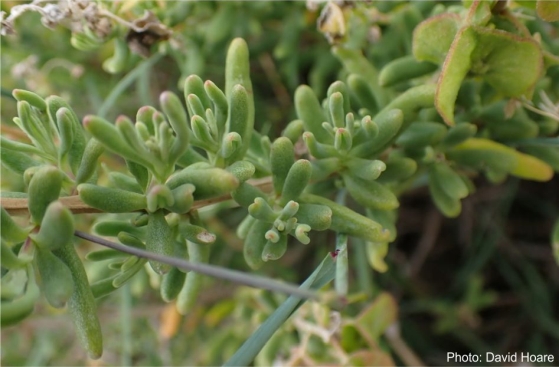
Growing Tetragonia fruticosa
Grow
Cuttings should be harvested in autumn (March-May) or summer (December-February) in the southern Hemisphere, use a clean sharp knife. Take tip cuttings 15-20 cm long, just below the node. Carefully remove most of the leaves except for the top few. Dip the bottom of the cutting in a rooting hormone, which is optional, to speed up the rooting formation and plant out in moist river sand in a container. Place the container with cuttings in it in a controlled environment, such as a glasshouse, away from the natural elements. Spray twice daily in the morning and evening using a mist sprayer and keep the soil moist. Monitor the progress of these cuttings on a daily basis. Once the cuttings have rooted, transplant them into the same soil mix used for seed sowing viz. 2 parts red soil, 2 parts compost and 1 part river-sand.
Seed usually matures in late spring (October). Sow seed in autumn (March in the southern hemisphere) in a well-drained medium of 2 parts red soil, 2 parts compost and 1 part river-sand which is sifted, the seed should be lightly loosened and covered with the same mixture.
Fresh seed will only germinate optimally after 2 years because they are in a hard envelope. The seeds should be soaked in cold water for 12 hours or warm water for 3 hours. This allows water to penetrate the seed with the cold water treatment or soften the seed coat with the warm water treatment to facilitate germination. The seeds must be well-spaced to prevent competition of seedlings once they start to germinate after 10-20 days.
No pests are known to feed on this plant.
In a garden situation, Tetragonia fruticosa can be planted with appropriate companion plants such as Aloe microstigma (Worcester aloe) with its spotted leaves and Crassula rupestris (kebab bush) with its interesting arrangement of leaves, sometimes tinged a reddish colour with pink flowers, Didelta carnosa (coast salad bush) with its strange striking yellow flowers, Drosanthemum micans (Robertson vygie) with its beautiful flowers with red outer petals and chrome yellow inner petals and Othonna arbuscula (traap), with its yellow daisy flowers and bonsai appearance.
References
- Foden, W. & Potter, L. 2005. Tetragonia fruticosa L. National Assessment: Red List of South African Plants version 2020.1. Accessed on 2022/02/17.
- Manning, J. & Goldblatt, P. 2012. Plants of the Greater Cape Floristic Region 1: the Core Cape Flora. Strelitzia 29. South African National Biodiversity Institute, Pretoria.
- Smith, C.A. 1966. Common names of South African plants. Memoirs of the Botanical Survey of South Africa No. 35. Government Printer, Pretoria.
- Van Breda, P.A.B. & Barnard, S.A. 1991. 100 Veld plants of the winter-rainfall region: a guide to the use of veld plants for grazing. Bulletin no. 422. Dept. of Agriculture Development, Cape & Transvaal Printers for the Government Printer, Pretoria.
- Van Wyk, B.-E. & Gericke, N. 2000. People's plants. Briza Publications, Pretoria.
- Vlok, J. & Schutte-Vlok, A. 2010. Plants of the Klein Karoo. Umdaus Press, Hatfield, Pretoria.
- Wikipedia, Tetragonia fruticosa. https://en.wikipedia.org/wiki/Tetragonia_fruticosa. Accessed 27/11/2022.
- World of Flowering Plants, Tetragonia fruticosa. https://worldoffloweringplants.com/tetragonia-fruticosa/. Accessed 26/11/2022.
Credits
Shireen Harris
Karoo National Botanical Garden
December 2022
Acknowledgements: the author thanks Sandra Falanga, David Hoare, Nanna Joubert and Nicola van Berkel for providing images.
Plant Attributes:
Plant Type: Ground Cover, Scrambler, Shrub, Succulent
SA Distribution: Eastern Cape, Northern Cape, Western Cape
Soil type: Sandy, Loam
Flowering season: Spring, Early Summer
PH: Acid, Alkaline, Neutral
Flower colour: Yellow
Aspect: Full Sun
Gardening skill: Easy
Special Features:
Horticultural zones









Rate this article
Article well written and informative
Rate this plant
Is this an interesting plant?
Login to add your Comment
Back to topNot registered yet? Click here to register.